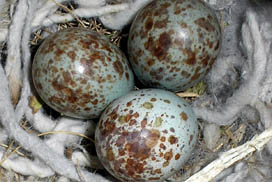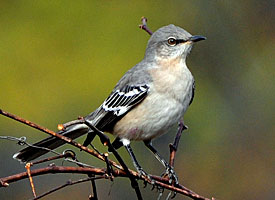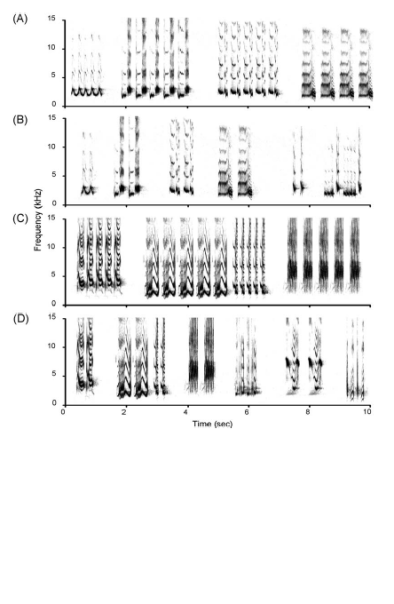By Kaitlin Fleming
Many people take the songs of birds for granted or don’t take the time to notice them at all. What they don’t understand is the complex actions required to make these beautiful songs. Also, most birds only have a few calls and songs that they can make. The Northern Mockingbird (Mimus polyglottos) and other birds of the family Mimidae are able to make up to and over a hundred different calls, depending on the bird. This is impressive because these birds are able to not only learn the songs of their own and other species, but they can also imitate noises from their surroundings. In this way the environment in which the bird is found affects the calls that it makes. This video shows some of the many different songs that the Northern Mockingbird sings, including some imitations of other bird’s calls.
Having helped rehabilitate animals for two and a half years at The Haven, we had many Northern Mockingbirds come in to our sanctuary. I quickly learned to recognize them by their grey coloration white markings on the wings, which is shown in the picture 2 below. I also noticed that the adults didn’t often make the same noises day in and day out as the doves or the grackles did. This piqued my curiosity and I began noticing these birds more in the wild and listening to the sounds they were making to see if I recognized them as something other than just a bird call. During my freshman year of college, I was walking around campus and noticed a Northern Mockingbird making a call that sounded exactly like a car alarm. This made me laugh and I immediately texted my friend to let her know of my discovery. She is just as interested in animals as I am and was also impressed that the bird could mimic the alarm so well.
On a beautiful sunny day, I was watched two mockingbirds as they chased a Northern Cardinal out of their territory. They were making all sorts of noises and various calls as they flew around the trees chasing after the cardinal. Once they had successfully ousted the intruder they came back to their tree and hopped around on the branches while continuing to make calls. I recognized the imitation of a car alarm, but the other calls must have been imitations of other birds because I they didn’t sound like anything I knew.
After taking a course in ornithology (the study of birds), I discovered just how complicated the voice box (called the syrinx) of a bird has to be to make the beautiful songs it sings, and the Northern Mockingbird’s singing impressed me even more. The most impressive thing I learned was how a bird can make two noises simultaneously, one sound from each side of the syrinx. However, this is not the only thing contributing to the production of sounds. The connections that a bird has in its brain contribute greatly to the number of songs it is able to sing.
After learning this I began to wonder why it would benefit a bird to be able to sing more songs or imitate more noises and how these birds with so many calls can tell the difference between their own species and that of other species, so I did some research.
A study by Zollinger et. al. included experiments on the production of sound by the Northern Mockingbird. Their studies were looking at the production of various sounds and the complexity of the sounds that these birds are able to produce. Image 1 shows a sonogram from their study showing a comparison of unilateral and bilateral sounds produced by the Northern Mockingbird. These results showed that some of the sounds that Northern Mockingbirds produce may not depend completely on neural control and are created due to the chemicals present in the tissues in and around the syrinx. I found this interesting because it gives a reason for birds of the same species and even of different species to have differences in their calls.
Another study that I found done by Reichard and Price specifically discussed how Northern Mockingbirds and other mimids distinguish between their own species and other species that they mimic. These researchers found that mockingbirds reacted more strongly to calls from their own species than to mimicked mockingbird calls done by another species or to calls of another species, the Brown Thrasher. This shows that the birds are able to distinguish between the calls of their own species and those of others, even when the species is mimicking the calls of the mockingbird.
However, there was one study that I found done by Owen-Ashley et. al. (2002) that showed that even though the imitations of other birds may fool us humans, the imitations are not perfect. They did a study playing the call of a Florida Scrub-Jay and the imitated call of a Florida Scrub-Jay by a Northern Mockingbird that showed that the imitation did not fool the Scrub-Jay. This shows that even though they may sound the same to most human ears, they are not identical to the call of the mimicked species.
Some studies are not always conclusive due to the complexity of quantifying data to test a hypothesis. When I was trying to find information about why it would be beneficial to be able to mimic other sounds, the studies did to always have an answer for me. Many of the studies I read discussed the hypothesis that the number of songs or calls was important in territory defense or for impressing a mate, but tests of these ideas were mostly inconclusive because it is difficult to measure data to support these points. The data that would support these points had to do with mate selection, which also has other factors involved and so it is difficult to determine which factor is affecting observed behavior.
This research adventure made me appreciate the beautiful calls of the songbirds that I hear every day. When I hear the Northern Mockingbird call I listen to see if it is mimicking an everyday sound or maybe even another bird and I observe its actions as it calls. Is it calling to another bird? Is it threatening another species? Is it flying around defending its territory or nest (see picture 1 for image of mockingbird nest)? As you walk around during your daily routine, take time to enjoy the birds that call in your area and remember the amazing system that is used to create those songs.
References
Derrickson, K. C. 1987. Yearly and situational changes in the estimate of repertoire size in Northern Mockingbirds (Mimus polyglottos). The Auk 104: 198-207.
This article discusses some earlier research done on the repertoire size of Northern Mockingbird males and how age and environment affect it.
Gammon, D. E., and C. E. Altizer. 2011. Northern Mockingbirds produce syntactical patterns of vocal mimicry that reflect taxonomy of imitated species. Journal of Field Ornithology 82: 158-64. DOI: 10.1111/j.1557-9263.2011.00318.x.
This article discusses possible patterns within the songs of mimics such as the Northern Mockingbird.
Owen-Ashley, N. T., S. J. Schoech, and R. L. Mumme. 2002 Context-specific response of Florida Scrub-Jay pairs to Northern Mockingbird vocal mimicry. The Condor 104: 858-65. DOI: 10.1650/0010-5422(2002)104[0858:CSROFS]2.0.CO;2
This article shows that the imitations done by mimics are not perfect because they do not fool the species it imitates, but they do not need to be in order to get a mate and territory.
Reichard, D. G., and J. J. Price. 2008. Species recognition in a vocal mimic: repetition pattern not the only cue by Northern Mockingbirds in discriminating songs of conspecifics and Brown Thrashers. The Wilson Journal or Ornithology 120: 717-24. DOI: 10.1676/07-162.1.
This article discusses how Northern Mockingbirds distinguish songs from their species versus other mimic species.
Wildenthal, J. L. 1965. Structure in primary song of the mockingbird (Mimus Polyglottos). The Auk 82: 161-89.
This article discusses the primary song of male Northern Mockingbirds in spring and early summer when defending their territory
Zollinger, S. A., T. Riede, and R. A. Suthers. 2008. Two-voice complexity from a single side of the syrinx in Northern Mockingbird Mimus Polyglottos vocalizations. The Journal of Experimental Biology. 211: 1978-1991. DOI:10.1242/jeb.014092.
This article describes how song is produced and research done on nonlinear vocalizations in Northern Mockingbirds.
Picture 1: The eggs of a Northern Mockingbird
Photo credit to Zoofari, taken from eNature website
Picture 2: The Northern Mockingbird
Photo by Jim Paris, taken from All About Birds website
Image 1: The data above is from a study done by Zollinger et. al (2008) on the Northern Mockingbird to show the difference between unilateral and bilateral sounds and their production. The first image is sound produced by one side of the syrinx and the second is the sound produced by both sides of the syrinx at the same time.
Image 2: This data is from a study done by Reichard and Price (2008) which shows the difference between mimicked and original songs from the Northern Mockingbird and the Brown Thrasher in a spectrograph. Line A shows a normal mockingbird pattern. Line B is a mockingbird imitating a Brown Thrasher. Line C is the thrasher imitating the mockingbird. And Line D is the normal thrasher pattern.





I found your article when conducting a search to learn how the voice box of a Mockingbird is shaped; thank you for sharing your information & knowledge! There is a Mockingbird that sings every night just outside my window, and I love hearing him sing his little heart out. I find the Mockingbird fascinating, and wonder why he sings so. This Mockingbird is nocturnal, but he’ll also sing mid-morning; but reliably anywhere from 1am – 4am. We are in San Jose, California. I set my cellular phone on the window sill and recorded him for 8-15 minutes several times, and I enjoy playing his Nocturnal Serenades during my time away, and other folks whom I have played the recordings for really enjoyed him as well. The Mockingbird is such a pure and sweet little being, and I am so grateful for their existence; and really appreciate that this one has chosen the place outside my window from which to serenade me!